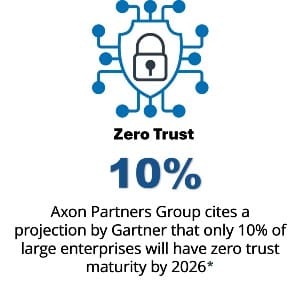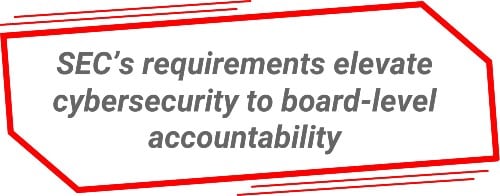
SEC cybersecurity rules are transforming enterprise security to Zero Trust architecture to protect sensitive data, ensure regulatory compliance, and strengthen board-level cybersecurity governance.
SEC Cybersecurity Rules Driving Zero Trust Architecture: What CIOs and CISOs Need to Know
Estimated reading time: 2 minutes
Table of Contents
Introduction: SEC Cybersecurity Rules Are Transforming Enterprise Security to Zero Trust

These rules, effective December 2023, are reshaping enterprise security and accelerating the adoption of Zero Trust architecture, particularly at the data layer, to reduce risk, improve visibility, and satisfy regulatory requirements.
Understanding the SEC’s New Cybersecurity Rules
The SEC’s rules focus on two primary areas:
-
Incident Disclosure (Form 8-K Cybersecurity Reporting)
-
- Companies must report material cybersecurity incidents within four business days of determining materiality.
- Disclosures must describe the nature, scope, timing, and material impact of the incident.
- Applies to incidents affecting on-premises, cloud, or third-party systems.
-
Annual Risk Management & Governance Reporting (Form 10-K)
-
- Firms must explain cybersecurity risk management processes and integration with business strategy.
- Disclosure must cover board oversight, management responsibilities, and how risks are identified, assessed, and mitigated.
- Effective compliance dates: Large registrants December 2023, smaller registrants June 2024.

Why SEC Cybersecurity Rules Drive Zero Trust Adoption
The SEC’s requirements elevate cybersecurity to board-level accountability, and Zero Trust architecture is uniquely suited to meet these obligations.
| SEC Driver | Zero Trust Alignment |
| Accountability & Governance | Measurable architecture with identity-based access, continuous verification, and least-privilege enforcement. |
| Material Risk Reduction | Microsegmentation and least-privilege access reduce lateral movement and contain breaches. |
| Visibility & Auditability | Continuous monitoring, access logging, and policy analytics provide audit-ready oversight. |
| Third-Party / Cloud Exposure | Extends “never trust, always verify” principles to suppliers, contractors, and cloud services. |
| Speed of Response | Automated access control and centralized policy management accelerate containment and reporting. |
Implications for CIOs and CISOs
- Board-Level Accountability: Zero Trust enables defensible reporting in SEC filings.
- Investment Justification: Spending on identity management, microsegmentation, monitoring, and secure data access becomes a compliance requirement.
- Operational Integration: Supports multi-cloud, remote work, and third-party access security.
- Data-Centric Protection: Extending Zero Trust to unstructured data mitigates risk of material incidents and ensures SEC compliance.
How FileFlex Enterprise Supports SEC Compliance

- Least-Privilege Access: Only authorized users can access sensitive unstructured data.
- Continuous Authentication & Monitoring: Logs all access for audit and SEC reporting purposes.
- Hybrid and Third-Party Coverage: Protects data across on-premises, cloud, and external storage.
With FileFlex, organizations reduce the risk of reportable breaches, strengthen governance visibility, and accelerate incident response to meet SEC disclosure requirements.
Conclusion
The SEC’s cybersecurity disclosure rules have transformed cybersecurity into a strategic, regulatory, and governance-driven requirement. Implementing Zero Trust architecture, particularly at the data layer, is essential for minimizing regulatory risk, protecting sensitive information, and demonstrating board-level accountability.
Organizations that adopt Zero Trust today will not only satisfy SEC compliance but also build a resilient security foundation capable of withstanding increasingly sophisticated cyber threats.
See also The Zero Trust Maturity Model and the Role of ZTDA, How to Build a Complete Zero Trust Security Framework, and Zero Trust for FFIEC Compliance: Why ZTDA Is the Missing Link.
FAQ: SEC Cybersecurity Rules and Zero Trust Architecture
1. What are the SEC’s new cybersecurity rules?
The SEC’s 2023 rules require public companies to disclose material cybersecurity incidents quickly (within four business days via Form 8-K) and report annually on cybersecurity risk management and governance in Form 10-K filings. These rules cover on-premises, cloud, and third-party systems.
2. Why are these rules driving Zero Trust adoption?
The rules create board-level accountability and require measurable risk reduction. Zero Trust architecture—featuring least-privilege access, microsegmentation, continuous monitoring, and identity verification—directly addresses these requirements by limiting exposure, improving visibility, and supporting audit-ready reporting.
3. How does Zero Trust architecture help companies comply with SEC rules?
Zero Trust provides structured controls that enforce secure access to critical data, log all access for audit purposes, and reduce the risk of lateral movement during breaches. These capabilities enable faster incident response, better reporting, and stronger governance documentation aligned with SEC requirements.
4. How can FileFlex Enterprise support SEC compliance?
FileFlex Enterprise extends Zero Trust to the data layer, securing unstructured data across on-premises, hybrid, and third-party environments. It enforces least-privilege access, continuous authentication, and full audit logging, helping organizations minimize material data exposure, demonstrate governance, and accelerate incident response for SEC filings.